 Stereo Power Amplifier P-550 Stereo Power Amplifier P-550
|
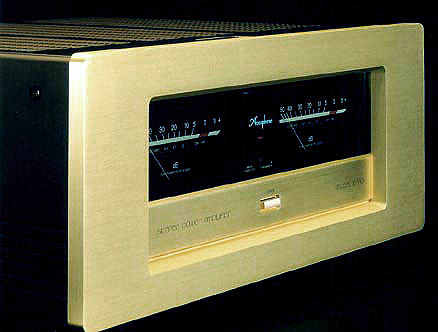
|
|
|
If an amplifier is to accurately provide a large current to its load, that is to say a loudspeaker, there are two essential prerequisites: the power supply must be capable of delivering ample energy, and the high-current output stage must be designed with low impedance so that its operation is not adversely affected by the load.
The latter requirement is especially important, because the impedance of a loudspeaker fluctuates considerably, depending on the frequency of the signal. Only an output stage with very low impedance will be able to assure accurate music reproduction under these demanding conditions.
To fulfill these demands, the P-550 employs multi-emitter type power transistors
specially developed for high-power audio applications. These advanced devices
have wide and flat frequency response, and their current amplification
linearity of forward-current transfer ratio as well as their switching
characteristics are excellent. With these transistors arranged in a 10-parallel
push-pull configuration, the P-550 achieves an impressive power output
rating of 270 watts into 8 ohms per channel. By using bridged mode, the
P-550 can be turned into a monaural power amplifier with an output of 840
watts into 8 ohms.
Another design highlight of theP-550 is the "current negative feedback"
principle. As opposed to conventional voltage NFB designs, there is virtually
no phase shift in the upper frequency range, and frequency response does
not change when gain is altered. This new type of circuit therefore provides
ideal amplification characteristics, combining operation stability with
excellent frequency response. Phase compensation can be kept at a minimum,
since only moderate amounts of NFB are required. This assures outstanding
transient response, and the advantages are clearly audible as superb sonic
realism and extraordinary detail resolution.
The basic source of energy for an amplifier is of course the power transformer
and the filtering capacitors. Consequently, the sonic end result depends
to a considerable degree on how much of a performance margin is built into
the power supply. The P-550 makes absolutely no compromises in this regard,
featuring a large toroidal power transformer and enormous filtering capacity.
And to maintain absolute sonic purity, all vital parts where the audio
signal passes, such as the traces on the printed circuit boards and input
and output terminals are gold-plated.
In the original Accuphase tradition, theP-550 features a champagne gold
colored front panel made from heavy, 15-mm thick extruded aluminum with
a hand-brushed finish. Its simple and uncluttered design gives the amplifier
an elegant and sophisticated visual appeal.
|
1.Powerful output stage with 10-parallel push-pull configuration delivers
550 watts into 2 ohms, 420 watts into 4 ohms, or 270 watts into 8 ohms
per channel
The output stage uses multi-emitter type power transistors specially developed
for audio applications and rated for a collector dissipation of 130 watts
and collector current of 15 ampere. These devices offer extraordinarily
wide and flat frequency response, and their linearity of forward-current
transfer ratio as well as their switching characteristics are outstanding.
By arranging these transistors in a 10-parallel push-pull configuration,
theP-550 achieves impressive power output capabilities, providing a full
550 watts into 2 ohms, 420 watts into 4 ohms, or 270 watts into 8 ohms
per channel. The driver stage employs power MOS-FETs with negative temperature
coefficient. These devices cancel out the positive temperature coefficient
of the bipolar power transistors, which guarantees perfectly stable operation
under all conditions.
|
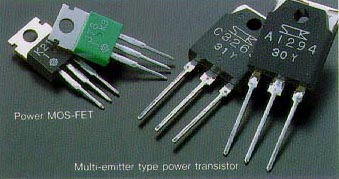
|
2.Current feedback circuit topology prevents phase shifts
When the gain of an amplifying circuit increases, frequency response, i.e.
the bandwidth that can be handled by the amplifier, becomes more narrow.
To counter this effect, a commonly employed technique called negative feedback
(NFB) routes part of the output signal back to the input. If phase shift
is disregarded, applying a high amount of NFB results in a circuit with
high gain and wide frequency response, as shown in Figure 2. Conventional
amplifiers employ voltage NFB, whereby a fraction of the output voltage
is used for the feedback loop. For the P-550, Accuphase developed a new
type of feedback circuit topology which uses the signal current rather
than voltage. Figure 3 shows the operating principle of this circuit. At
the input point of the feedback loop, the impedance is kept low and current
detection is performed. A trans-impedance amplifier then steps up the impedance
and converts the current into a voltage to be supplied to the output. Since
the impedance at the current feedback point (current adder in Fig. 3) is
very low, there is almost no phase shift. Phase compensation therefore
can be kept at a minimum, resulting in excellent transient response and
superb sonic transparency. With this circuit, there is virtually no change
in frequency response when gain is altered. Figure 4 shows frequency response
for different gain settings of the current feedback amplifier. The graphs
demonstrate that response remains uniform over a wide range. |
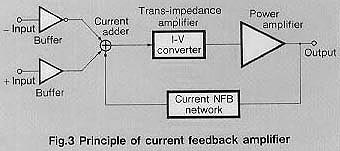
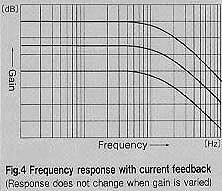
|
3.Bridged operation mode creates a true monophonic amplifier with 1,100
watts into 4 ohms and 840 watts into 8 ohms
Bridged mode means that the two channels of an amplifier are driven with
the same signal voltage but with opposite phase, and their output is combined.
The P-550 provides a switch arrangement for bridged operation, which turns
the unit into a high-grade monaural amplifier capable of delivering a full
1,100 watts into 4 ohms and 840 watts into 8 ohms. Simply by adding another
P-550 to form a stereo amplifier pair, a further dramatic improvement in
sonic performance can be achieved.
|
4.Balanced connection reliably blocks induced noise
As illustrated by Figure 5, balanced signal transmission means that the
output stage of a component supplies two signal lines, having identical
voltage but opposite phase. On the input side, these signals are fed to
a positive and negative amplifier circuit and then mixed. Since any noise
interference that has arisen during transmission will be present in both
lines with identical phase, such noise is canceled out, leaving only the
pure signal. The longer the cable connections between audio components,
the higher is the danger of external noise being introduced into the signal
path, which invariably leads to sound quality degradation. The balanced
connection principle reliably prevents this danger, by keeping the signal
transfer completely free from any kind of interference. In the P-550, as
shown in Figure 6, the balanced signal is connected directly to inverting
(+) and non-inverting (-) input stages, which results in ideal balanced
operation.
|
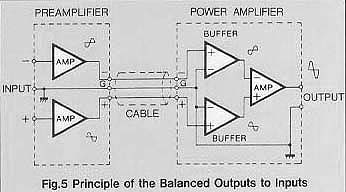
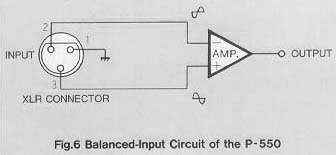
|
5.All signal paths are gold-plated
High-purity copper is commonly used in audio components for signal path
lines. TheP-550 does this one better, by providing gold-plating. This includes
not only the copper traces on printed circuit boards but also ground bars
carrying large ripple currents, bus bars providing current to the power
transistors, input jacks, and speaker terminals. The input jacks with their
high usage frequency have a coating that is 10 times thicker than on conventional
jacks. This thorough approach results in a distinct sonic improvement.
|
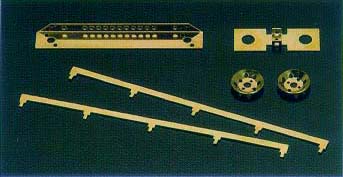
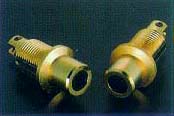
|
6.Robust power supply with large toroidal power transformer and high filtering
capacity
In any amplifier, the power supply plays a vital role as the source of
energy for the entire unit. The P-550 spares no efforts in this regard,
featuring a large, highly efficient 1,200 VA toroidal power transformer.
This transformer type is ideal for high-power amplifiers, since it is characterized
by very low impedance, compact size, and very high conversion efficiency.
In addition, two enormous electrolytic capacitors, each rated for 47,000
uF/100 WV (electrical charge 4.7 Coulomb) provide more than ample filtering
capacity for the rectified current.
|
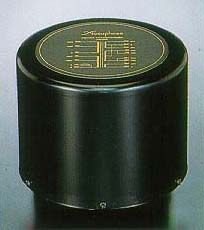 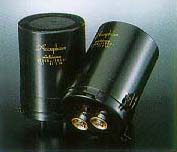
|
Large power meters, and speaker terminals
The large analog power meters let you easily monitor the output level. The oversize gold-plated speaker terminals accept even very heavy-gauge speaker cable, and it is also possible to insert banana plugs into the binding posts.
Two switchable sets of outputs allow independent use or bi-wiring (supplying the same signal via dual leads to speakers with separate high-frequency and low-frequency inputs).
|
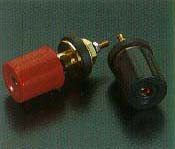
|
|
|
|
|
|
|
|